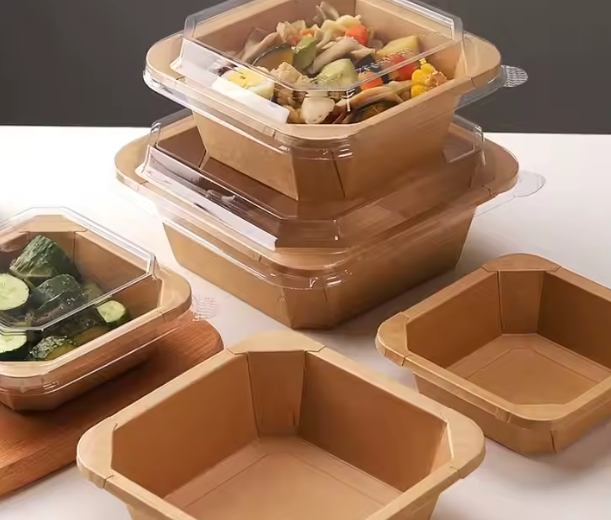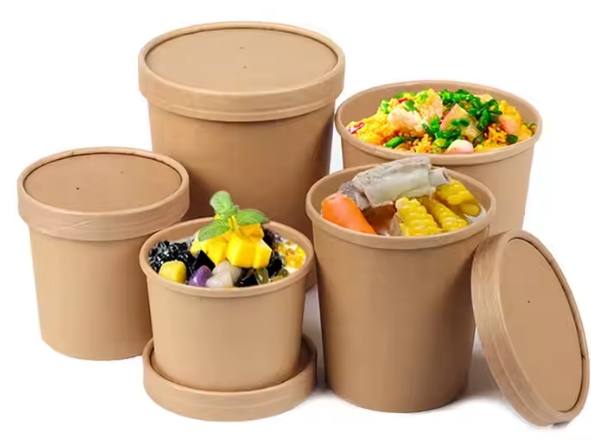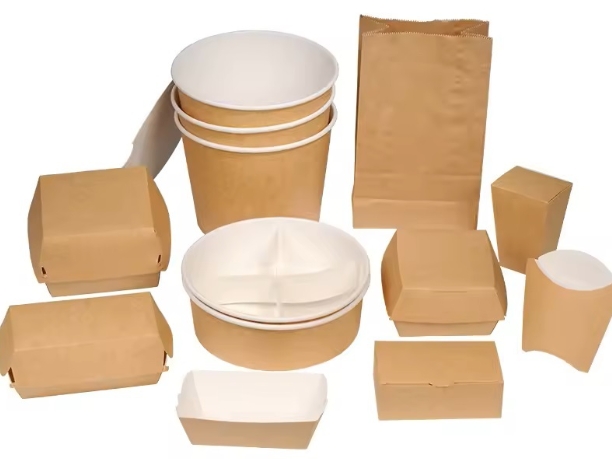
Content Menu
● Understanding Disposable Food Grade Paper Bowl Lids
>> What Does "Food Grade" Mean?
>> Key Features of Disposable Food Grade Paper Bowl Lids
● Materials Used in Eco-Friendly Paper Bowl Lids
>> 1. Food-Grade Paperboard
>> 2. Biodegradable Coatings
>> 3. Inks and Adhesives
● Manufacturing Process of Disposable Food Grade Paper Bowl Lids
>> Step 1: Raw Material Preparation
>> Step 2: Coating Application
>> Step 3: Printing
>> Step 4: Die-Cutting and Forming
>> Step 5: Quality Control
>> Step 6: Packaging and Distribution
● Environmental Benefits of Disposable Food Grade Paper Bowl Lids
>> Biodegradability and Compostability
>> Reduced Carbon Footprint
>> Conservation of Resources
>> Avoidance of Toxic Chemicals
>> Waste Reduction
● Practical Advantages of Disposable Food Grade Paper Bowl Lids
>> Leakproof and Secure Fit
>> Heat and Cold Resistance
>> Versatility
>> Customization and Branding
>> Cost-Effectiveness
>> Consumer Appeal
● Applications of Disposable Food Grade Paper Bowl Lids
>> Restaurants and Takeaways
>> Catering and Events
>> Food Trucks and Street Vendors
>> Household Use
>> Institutional Use
● Comparison: Disposable Food Grade Paper Bowl Lids vs. Plastic Lids
● Innovations and Future Trends in Eco-Friendly Paper Bowl Lids
>> Advanced Biodegradable Coatings
>> Enhanced Composting Infrastructure
>> Circular Economy Models
>> Smart Packaging
● Conclusion
● FAQ
>> 1. What materials are disposable food grade paper bowl lids made from?
>> 2. Are disposable food grade paper bowl lids compostable?
>> 3. Can these paper bowl lids be used for hot and cold foods?
>> 4. How do disposable paper bowl lids compare environmentally to plastic lids?
>> 5. Can I customize disposable food grade paper bowl lids with my brand logo?
● Citations:
Disposable food grade paper bowl lids have become a cornerstone in the movement toward sustainable food packaging. As consumers and businesses alike grow more environmentally conscious, the demand for eco-friendly alternatives to traditional plastic lids has surged. This article delves deeply into what makes disposable food grade paper bowl lids eco-friendly, exploring their materials, manufacturing processes, environmental benefits, practical applications, and how they compare to conventional plastic lids. By the end, you will have a comprehensive understanding of why these lids are not only a smart choice for the planet but also for food safety and business branding.

Understanding Disposable Food Grade Paper Bowl Lids
Disposable food grade paper bowl lids are designed to cover and seal disposable bowls used primarily for food packaging, especially in takeout, delivery, and catering services. Their primary function is to protect food from contamination, prevent spills, and maintain temperature, all while being safe for direct contact with food.
What Does "Food Grade" Mean?
The term “food grade” indicates that the materials used in the lid are safe for direct contact with food. This means the paper and coatings do not leach harmful chemicals or toxins into the food, ensuring consumer safety. Food grade certification involves rigorous testing to meet health and safety standards set by regulatory bodies such as the FDA (Food and Drug Administration) or EFSA (European Food Safety Authority).
Key Features of Disposable Food Grade Paper Bowl Lids
- Food-Safe Materials: Made from paperboard that meets food safety standards.
- Waterproof and Greaseproof: Coated with biodegradable linings to prevent leaks.
- Heat Resistant: Suitable for hot foods and microwave use.
- Leakproof Design: Secure fit to prevent spills during transport.
- Customizable: Can be printed with logos and designs using eco-friendly inks.
- Variety of Sizes: Available to fit different bowl diameters and volumes.
These features make disposable food grade paper bowl lids a practical and sustainable choice for food packaging.
Materials Used in Eco-Friendly Paper Bowl Lids
The eco-friendliness of disposable food grade paper bowl lids largely depends on the materials used in their production. Let's explore the primary components:
1. Food-Grade Paperboard
The base material is typically a thick, sturdy paperboard that is safe for food contact. This paperboard is often sourced from sustainably managed forests certified by organizations such as FSC (Forest Stewardship Council) or PEFC (Programme for the Endorsement of Forest Certification). Alternatively, agricultural byproducts like sugarcane bagasse, bamboo, or wheatgrass fibers are increasingly used as renewable raw materials.
- Sugarcane Bagasse: A fibrous residue left after extracting juice from sugarcane. It is abundant, renewable, and biodegradable.
- Bamboo: Fast-growing and requires minimal pesticides, bamboo fibers are an excellent sustainable alternative.
- Wheatgrass and Other Agricultural Fibers: These byproducts reduce waste and provide a renewable source for paper production.
2. Biodegradable Coatings
To make the paperboard waterproof and greaseproof, coatings are applied. Traditional plastic coatings are not eco-friendly, so alternatives include:
- PLA (Polylactic Acid): Derived from fermented plant starch (usually corn), PLA is compostable and biodegradable. It creates a moisture barrier while maintaining the paper's compostability.
- PE (Polyethylene): A thin layer of PE is sometimes used, but it is less biodegradable than PLA. However, some manufacturers use PE coatings that are recyclable in certain facilities.
- Water-Based Coatings: Some companies are innovating with water-based coatings that provide grease resistance without plastic.
3. Inks and Adhesives
Eco-friendly inks made from soy or vegetable oils are used for printing on the lids. These inks are free from heavy metals and volatile organic compounds (VOCs), making them safer for the environment and food contact. Similarly, adhesives used in the manufacturing process are chosen to be non-toxic and biodegradable.
Manufacturing Process of Disposable Food Grade Paper Bowl Lids
The production of disposable food grade paper bowl lids involves several carefully controlled steps to ensure quality, safety, and sustainability.
Step 1: Raw Material Preparation
Sustainable paperboard or bagasse pulp is prepared and processed into sheets of the desired thickness. The pulp is cleaned and bleached using environmentally friendly methods to avoid harmful chemicals.
Step 2: Coating Application
The paperboard sheets are coated with a thin layer of PLA or other biodegradable materials. This coating is applied evenly to ensure the lid is waterproof and greaseproof while maintaining compostability.
Step 3: Printing
Using eco-friendly inks, manufacturers print logos, product information, or decorative designs on the coated paperboard. This step allows businesses to customize lids for branding purposes without compromising sustainability.
Step 4: Die-Cutting and Forming
The printed and coated sheets are die-cut into circular shapes matching bowl sizes. The edges are then formed or curled to create a secure fit over the bowl rim.
Step 5: Quality Control
Each batch undergoes rigorous testing to ensure lids meet food safety standards, fit properly, and maintain leakproof and heat-resistant properties.
Step 6: Packaging and Distribution
The finished lids are packed in bulk using recyclable or compostable packaging materials and shipped to food service providers.
Environmental Benefits of Disposable Food Grade Paper Bowl Lids
The eco-friendly nature of disposable food grade paper bowl lids stems from their materials, biodegradability, and reduced environmental footprint.
Biodegradability and Compostability
One of the most significant advantages is that these lids break down naturally in composting environments. Unlike plastic lids, which can persist in landfills and oceans for hundreds of years, paper bowl lids coated with PLA or similar materials decompose within 90 days in industrial composting facilities. This process returns valuable nutrients to the soil and reduces landfill waste.
Reduced Carbon Footprint
The production of paper bowl lids generally requires less energy and emits fewer greenhouse gases compared to plastic manufacturing. Using renewable raw materials like bagasse or bamboo further reduces carbon emissions by avoiding fossil fuel extraction.
Conservation of Resources
By utilizing agricultural byproducts and sustainably harvested fibers, disposable food grade paper bowl lids help conserve natural resources and reduce deforestation. This circular approach to materials supports sustainable agriculture and forestry.
Avoidance of Toxic Chemicals
These lids avoid the use of harmful chemicals such as BPA (Bisphenol A), phthalates, and heavy metals commonly found in some plastic products. This not only protects the environment but also ensures food safety for consumers.
Waste Reduction
Because these lids are compostable, they contribute to organic waste streams rather than adding to plastic pollution. Many municipalities now offer composting programs that accept such materials, further encouraging responsible disposal.

Practical Advantages of Disposable Food Grade Paper Bowl Lids
Beyond environmental benefits, disposable food grade paper bowl lids offer several practical advantages for food service businesses and consumers.
Leakproof and Secure Fit
The lids are designed to fit snugly on bowls, preventing leaks and spills during transport. This is especially important for liquid or semi-liquid foods like soups, stews, and sauces.
Heat and Cold Resistance
These lids can withstand a wide temperature range, making them suitable for hot foods, microwave reheating, and freezer storage without warping or releasing toxins.
Versatility
Disposable food grade paper bowl lids are compatible with a variety of bowl types and sizes, making them ideal for serving soups, salads, desserts, and more.
Customization and Branding
Businesses can print their logos, slogans, or promotional messages on the lids using eco-friendly inks. This not only enhances brand visibility but also communicates a commitment to sustainability to customers.
Cost-Effectiveness
While sometimes slightly more expensive than plastic lids, paper bowl lids offer long-term savings by reducing waste disposal costs and appealing to eco-conscious consumers who may prefer sustainable packaging.
Consumer Appeal
With growing awareness of environmental issues, customers increasingly prefer businesses that use sustainable packaging. Offering disposable food grade paper bowl lids can improve customer loyalty and brand reputation.
Applications of Disposable Food Grade Paper Bowl Lids
The versatility and eco-friendliness of disposable food grade paper bowl lids make them suitable for a wide range of applications.
Restaurants and Takeaways
Ideal for restaurants offering takeout or delivery, these lids keep food fresh and secure during transport while reducing plastic waste.
Catering and Events
Large-scale catering services benefit from the convenience and sustainability of paper bowl lids, especially for outdoor events and festivals.
Food Trucks and Street Vendors
Lightweight and easy to handle, these lids are perfect for mobile food businesses that need reliable, eco-friendly packaging.
Household Use
Consumers can use disposable food grade paper bowl lids for meal prep, leftovers, and picnics, supporting sustainable living at home.
Institutional Use
Schools, hospitals, and corporate cafeterias can adopt these lids to reduce their environmental footprint and promote health and safety.
Comparison: Disposable Food Grade Paper Bowl Lids vs. Plastic Lids
| Feature | Disposable Food Grade Paper Bowl Lid | Plastic Lid |
| Material Source | Renewable (bagasse, bamboo, paper) | Fossil fuel-based |
| Biodegradability | Yes, compostable within 90 days | No, takes hundreds of years |
| Chemical Safety | Free from harmful toxins | May contain BPA, phthalates |
| Carbon Footprint | Lower emissions in production | Higher emissions |
| End-of-Life Disposal | Compostable or recyclable | Mostly landfill or limited recycling |
| Heat Resistance | Microwave and freezer safe | Microwave safe but less eco-friendly |
| Customization | Easy with eco-friendly inks | Easy but less sustainable |
| Consumer Appeal | High among eco-conscious consumers | Declining due to environmental concerns |
This comparison highlights why disposable food grade paper bowl lids are increasingly favored in sustainable food packaging.
Innovations and Future Trends in Eco-Friendly Paper Bowl Lids
The market for disposable food grade paper bowl lids continues to evolve with innovations aimed at improving sustainability and functionality.
Advanced Biodegradable Coatings
Research is ongoing into coatings derived from algae, chitosan (from crustacean shells), and other natural polymers that could replace PLA and PE, offering even better compostability and barrier properties.
Enhanced Composting Infrastructure
As composting facilities expand globally, the ability to properly dispose of paper bowl lids improves, encouraging wider adoption.
Circular Economy Models
Some manufacturers are developing closed-loop systems where used paper bowl lids are collected, composted, and the resulting compost supports raw material growth, creating a sustainable cycle.
Smart Packaging
Integration of QR codes or NFC tags printed with eco-friendly inks can provide consumers with information about the product's sustainability, disposal instructions, and brand story.
Conclusion
Disposable food grade paper bowl lids represent a vital step forward in sustainable food packaging. Their use of renewable, biodegradable materials such as sugarcane bagasse and PLA coatings ensures they are environmentally responsible alternatives to plastic lids. These lids not only reduce pollution and landfill waste but also lower carbon footprints and avoid harmful chemicals, making them safer for consumers and the planet.
In addition to their environmental benefits, disposable food grade paper bowl lids offer practical advantages including leakproof design, heat resistance, and customization options that appeal to businesses and consumers alike. As innovations continue and composting infrastructure improves, these lids are poised to become the standard in eco-conscious food service packaging.
By choosing disposable food grade paper bowl lids, businesses can demonstrate their commitment to sustainability, meet regulatory requirements, and satisfy the growing demand from eco-aware customers. Ultimately, these lids contribute to a healthier planet and a more sustainable future for the food industry.

FAQ
1. What materials are disposable food grade paper bowl lids made from?
Disposable food grade paper bowl lids are primarily made from food-grade paperboard sourced from sustainable forests or agricultural byproducts like sugarcane bagasse and bamboo. They are coated with biodegradable materials such as PLA (polylactic acid) or sometimes PE (polyethylene) to make them waterproof and greaseproof.
2. Are disposable food grade paper bowl lids compostable?
Yes, most disposable food grade paper bowl lids coated with PLA are fully compostable and biodegradable under industrial composting conditions. They typically break down within 90 days without leaving harmful residues, making them an eco-friendly alternative to plastic lids.
3. Can these paper bowl lids be used for hot and cold foods?
Absolutely. These lids are designed to withstand a wide temperature range, making them suitable for hot soups, cold salads, microwave reheating, and freezer storage without warping or releasing toxins.
4. How do disposable paper bowl lids compare environmentally to plastic lids?
Disposable food grade paper bowl lids have a significantly lower environmental impact. They are made from renewable resources, biodegrade quickly, and have a smaller carbon footprint compared to plastic lids, which are fossil fuel-based and persist in the environment for centuries.
5. Can I customize disposable food grade paper bowl lids with my brand logo?
Yes, many manufacturers offer custom printing services using eco-friendly inks. This allows businesses to print logos, slogans, or designs on the lids, enhancing brand visibility while maintaining sustainability.
Citations:
[1] https://www.biopak.com/hk-ch/containers-lids/bowls
[2] https://mysupplyclub.com/product-category/food-containers/bowls-and-lids/
[3] https://www.qiaowang.net/industry-news/opting-for-eco-friendly-disposable-paper-bowls-a-sustainable-shift-from-plastic/
[4] https://zjpypaper.en.made-in-china.com/product/TnBYzqErgjkZ/China-Disposable-Brown-Kraft-Paper-Bowls-Food-Packaging-Bowl-with-Lid.html
[5] https://www.kailaipak.com/video/products-detail-488425
[6] https://www.bioleaderpack.com/he/product/disposable-paper-bowls-with-lids/
[7] https://www.glamanpaperlid.com/faq_nc3
[8] https://www.glamanpaperlid.com/food-grade-eco-friendly-paper-bowls-rectangular-bowls_p273.html
[9] https://www.glamanpaperlid.com/eco-products-renewable-sustainable-paper-lid_p1.html
[10] https://www.pinterest.com/pin/45-pack-deli-kraft-paper-bowl-with-secure-clear-lids-ecofriendly-microwavable-round-food-containers--773774779756517748/
[11] https://www.mviecopack.com/disposable-ecofriendly-white-paper-bowl-with-lid-food-container-product/
[12] https://chinafoodcontainer.en.made-in-china.com/product/IdsAmnxcqaRo/China-Eco-Friendly-Environmental-Kraft-Paper-Bowl-with-Secure-Lid-for-Food.html
[13] https://www.eco-harvest.com/products/eco-friendly-kraft-paper-soup-bowl-ice-cream-hot-cold-drink-dessert-packaging-food-grade-takeaway-disposable-paper-cup-with-lid
[14] https://en.hydepackage.com/info-detail/some-reasons-for-the-popularity-of-paper-bowl-with-lid
[15] https://whhaokelao.en.made-in-china.com/product/cweTRBEYaPrI/China-Eco-Friendly-Disposable-Kraft-Paper-Salad-Bowl-with-Paper-and-Plastic-Lid.html
[16] https://www.shutterstock.com/search/disposable-paper-bowl
[17] https://www.shutterstock.com/search/disposable-bowl
[18] https://www.alibaba.com/showroom/disposable-bowls-with-lids-pictures.html
[19] https://www.istockphoto.com/photos/plastic-bowl-with-lid
[20] https://www.youtube.com/watch?v=mKnFWlRF2Pg
[21] https://whhaokelao.en.made-in-china.com/product/KZIanQSvChUe/China-Disposable-Salad-Bowl-Paper-Salad-Bowl-with-Food-Grade-with-Pet-Lid.html
[22] https://www.vegware.hk/hk/page/faq/
[23] https://gmz.ltd/how-to-choose-the-right-paper-bowl-sizes-a-quick-guide/
[24] https://www.biopak.com/hk/containers-lids/bowls
[25] https://www.dixie.com/faq
[26] https://www.easyngreen.com/eight-common-questions-about-ecofriendly-disposable-utensils.html
[27] https://takeawaypackaging.co.uk/takeaway-food-boxes-frequently-asked-questions/
[28] https://www.mviecopack.com/news/kraft-paper-containers-your-essential-guide-to-smart-purchases/
[29] https://www.yanxiyan.com/paper-bowl/

















